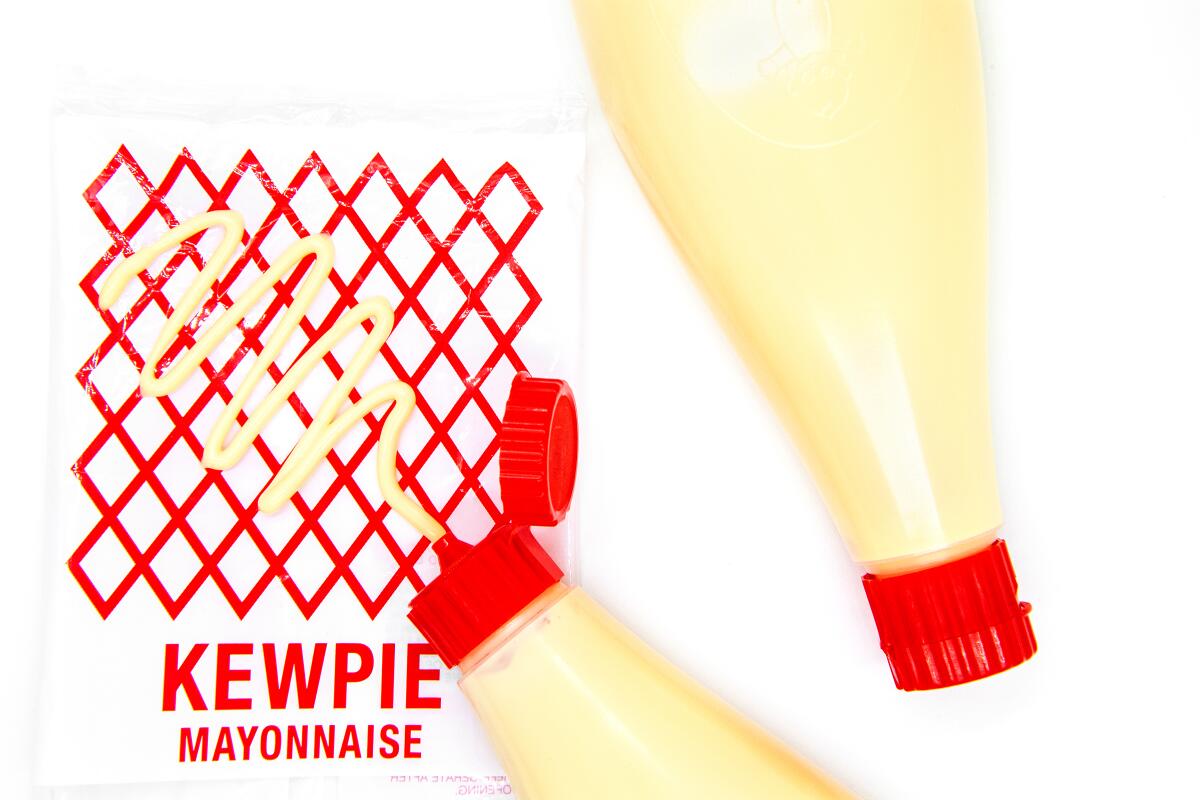Is this the world’s best mayonnaise?

- Share via
The first step in understanding the popularity of Kewpie mayonnaise is to recognize there are different attitudes in Japan than in America regarding the creamy condiment. It’s used extensively — on salads, karaage, squiggled onto okonomiyaki and takoyaki, and even as a pizza topping. It has transcended the plane of mere human consumption to become a cultural touchstone — a passion that can border on obsession.
Is there a Kewpie mayonnaise museum in Japan, called MayoTerrace? There most certainly is. Are there pop-up mayo cafes in Japan, featuring Kewpie-centric menu items? Of course.
The mayonnaise is a favorite of chefs everywhere. Niki Nakayama of n/naka fills onigiri with a tuna-and-Kewpie mixture. Jordan Kahn of Vespertine used it in a banh mi at his old place, Red Medicine. Sushi chef Tim Phung noted, “It’s the king of mayonnaise.”
The progression of Kewpie from small-time sauce and canned-goods maker to national icon begins in 1919 in Tokyo with the founding of Shokuhin Kogyo, now the Kewpie Corp. The company began manufacturing mayonnaise in 1925, adopting the same image and name of Kewpie dolls, the adorable, slightly creepy-looking cherubim created by illustrator Rose O’Neill in 1909.
Japanese products are often extremely well designed, and Kewpie is no exception. The sweet little baby on the packaging is extremely kawaii. The thin, slightly textured plastic of the bottle feels fantastic in your hands. The nozzle tip allows for the administration of fine squiggles. But you can also unscrew the nozzle completely, and you’ll find a wider, star-shaped opening that will let you pipe Kewpie as if you were Pierre Hermé.
And of course, there’s the flavor of Kewpie that sets it apart from competitors. It uses egg yolks, as opposed to the entire egg, which gives the mayo a denser, smoother texture — not the meringue-like fluffiness of a Hellmann’s. According to a downloadable Kewpie ebook on the company’s website, the mayo included twice as much yolk as its competitors when it was first released.
So what does it taste like, anyway? I’ve had plenty of Kewpie throughout the years, mostly in Japanese restaurants, but I went to the grocery store last week to buy a bottle to refresh my memory. It’s not like normal mayo — the purpose of it isn’t to merely add “zing” to your favorite dressings and sandwiches, as American commercials throughout the decades would suggest.
The initial taste is mellower, creamier, even slightly fruity. The egginess is certainly stronger because of the yolk content, but it isn’t overpowering. There’s no added sugar, so it doesn’t have that cloying sweetness of a Miracle Whip.
While Kewpie itself doesn’t necessarily hit you over the head with flavor, one of its ingredients gives it a leg up on the competition: monosodium glutamate, or MSG. Kewpie famously, proudly, lists MSG on the ingredient list (but doesn’t include it in its inferior version made for American markets — always get the Japanese version).
I’m not one of those annoying normcore activists who insists MSG and American cheese be put into everything, but I certainly believe MSG has its uses and firmly reject the idea that it’s somehow worse for you than other kinds of sodium. It triggers umami, the famous fifth taste, which can best be described as a kind of earthiness or depth of flavor.
The addition of MSG means Kewpie makes the taste of whatever you’re using it on — fried chicken, a BLT or french fries — pop a little bit more. Those fries are going to seem more potato-ey. The fried chicken will seem more juicy and flavorful. Kewpie adds a sforzando to a dish, to put it in musical terms — the note is the same, it’s just louder.
There will always be, naturally, people who say they hate mayo, full stop. I was once one of them. Give Kewpie a shot. And don’t forget: If you like aioli or tartar sauce, then you like mayonnaise. They’re the same thing.
More to Read
Eat your way across L.A.
Get our weekly Tasting Notes newsletter for reviews, news and more.
You may occasionally receive promotional content from the Los Angeles Times.











